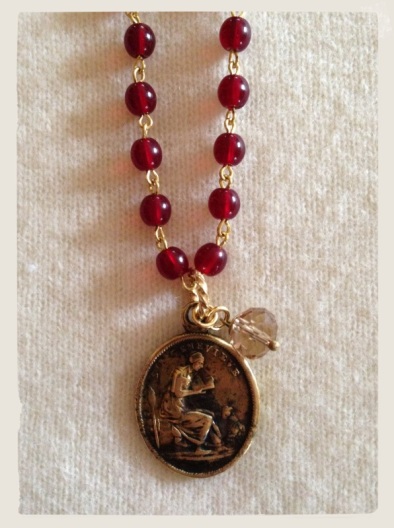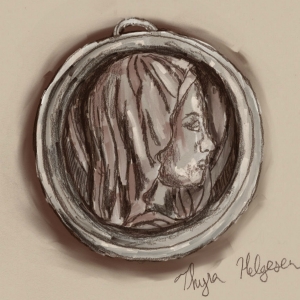Tags
19th century brass St. Geneviève religious medal France, 19th century French religious medals, Brass St. Geneviève medal France, Cathédrale de Rennes, Catholic pilgrimages in France, Clignancourt, Devotional Medals, El Camino de Santiago pilgrimage route France and Spain, French religious pilgrimage medals, holy shrines in France, holy sites in France, Le Marché aux Puces de Saint-Ouen, Lourdes medal France 1930s, médailles de pèlerinage, Medieval European Pilgrimage, Middle ages French Catholic pilgrimages, Paris flea markets, religious souvenirs, Sacred Heart medal France 1800s, St. Olaf College
Share it
By Jen Westmoreland Bouchard
As I amble down the narrow walkways that comprise Le Marché aux Puces de Saint-Ouen (Paris’s largest and best known flea market), my gaze falls on a retired carousel horse. He is seafoam green and evokes a childhood gone by—not mine, someone else’s—a young Parisienne in the 1930s perhaps. I decide that I must have him, and immediately begin negotiations with the stall owner. Halfway through my haggling, I come to my senses. I’ll eventually have to leave France to finish my undergraduate degree back home at St. Olaf College, and, given my limited financial resources, my equine companion would not be able to make the trip with me. So I let him go, reluctantly, reassuring myself I will find smaller treasures that are just as captivating.

Sacred Heart medal, France, 1800s (left) Lourdes medals, 1930s (middle, right). Necklaces designed by Jen Westmoreland Bouchard, Litany Jewelry Designs
And eventually I do, just a few stalls down, in fact. In a casket-style glass jewelry box from the turn of the 19th century, I spot a trio of antique brass religious medals. I ask the elderly stall owner if I can see them more closely and she removes them from their long-time home with a bemused smile. As she places them one by one in my palm, I am drawn in by their beauty: centime-sized pieces of art, perfectly worn from years of being rubbed during prayer and meditation. My connection to them is not purely aesthetic; like the carousel horse several meters away; they transport me to another time, to another life, to a set of values and desires that are at once familiar and foreign. The stall owner tells me they are médailles de pèlerinage, medals received by religious pilgrims as they visited significant sites along their journey. I purchase them on the spot, and six months later, they travel from CDG to MSP, nestled between my well-used copy of Le Petit Robert (my first purchase upon setting foot in France) and my gant de toilette (a gift from my host mother when she saw how amused I was by the quintessential “Frenchness” of it).

Brass St. Geneviève medal, France, early 1800s.
Necklace designed by Jen Westmoreland Bouchard, Litany Jewelry Designs
Since that day of treasure hunting in Paris in the winter of 2000, I have been fascinated by antique religious medals, not only because of the cultural clues and historical relevance they contain, but also because of their personal significance, what they meant to those who owned them. I have been fortunate to acquire a beautiful collection of antique medals (of French and other origins), some centuries old. Though I treasure all of them for different reasons, the pilgrimage medals, like the ones I purchased at Clignancourt thirteen years ago, summon the strongest imagery.
Catholic pilgrimages in France date back to the Middle Ages. People of faith undertook these arduous journeys as a way of deepening their religious devotion, seeking forgiveness for their sins, searching for physical and spiritual healing (in the form of a miracle), and for the spiritual experience of the journey itself. While each pilgrimage leads to a specific destination (typically a holy site on which now stands a cathedral), the experience is not solely about reaching the end; it is about what is endured, enjoyed, and learned along the way.[i]
France is home to world-famous pilgrimage sites, including Lourdes (site of the Marian apparitions), La Basilique de St. Thérèse in Lisieux, and Sacré-Coeur in Paris.
El Camino de Santiago, a pilgrimage route featured in the 2010 film, The Way, begins at four starting places in France (pilgrims choose where they wish to begin), and leads travelers to Santiago de Compostela in northern Spain.
Since the Middle Ages, pilgrimage medals had been forged and used in France as a way for pilgrims to mark their visit to a specific shrine or holy site during their journey—religious souvenirs, if you will. The medals were also worn for strength and religious inspiration. Some pilgrims wore theirs in a prominent place (attached to the outside of their clothing) to indicate to others that they had completed a pilgrimage. Over time, these medals have become highly collectible, admired for their craftsmanship and often times their rarity.[ii]
They are travelers’ art: portable, meaningful, beautiful. This year, I purchased two pilgrimage medals as a birthday gift to myself; one depicting the Cathédrale de Rennes (the Breton city where I lived in my early twenties), and the other a rare turn-of-the-19th-century medal portraying St. Geneviève (the patron saint of Paris, another city I have been fortunate to call home). In these medals, I see the significance of past quests and the promise of journeys not yet taken; those of the body, mind and heart. They remind me of lessons I have learned on my own voyages, inspire me to continue seeking, and to appreciate beauty in its myriad forms along the way.
[i] Webb, Diana. Medieval European Pilgrimage. New York: Palgrave, 2002.
[ii] Thurston, Herbert. “Devotional Medals.” The Catholic Encyclopedia. Vol. 10. New York: Robert Appleton Company, 1911.
 Jen Westmoreland Bouchard holds a B.A. in French and a B.A. in Interdisciplinary Fine Arts from St. Olaf College (Northfield, Minnesota) and a M.A. in French and Francophone Studies from University of California-Los Angeles. She is a faculty member in the World Languages Department at Normandale Community College (Bloomington, Minnesota) where she teaches courses on French language and culture. Bouchard is the owner of a boutique translation, writing, and editing agency, Lucidité Writing, LLC (www.luciditewriting.com). Her newest venture, Litany Jewelry Designs (http://www.facebook.com/litanyjewelry) keeps her busy designing and handcrafting jewelry with vintage and antique medals.
Jen Westmoreland Bouchard holds a B.A. in French and a B.A. in Interdisciplinary Fine Arts from St. Olaf College (Northfield, Minnesota) and a M.A. in French and Francophone Studies from University of California-Los Angeles. She is a faculty member in the World Languages Department at Normandale Community College (Bloomington, Minnesota) where she teaches courses on French language and culture. Bouchard is the owner of a boutique translation, writing, and editing agency, Lucidité Writing, LLC (www.luciditewriting.com). Her newest venture, Litany Jewelry Designs (http://www.facebook.com/litanyjewelry) keeps her busy designing and handcrafting jewelry with vintage and antique medals.
You may also enjoy A Woman’s Paris® post, French Crown Jewels: Empress Eugénie, by Barbara Redmond who writes about pieces from Empress Eugénie’s private collection and the French Crown Jewels that were split up by the national assembly and sold at public auction. Stories of Empress Eugénie’s famous Bow Brooch, Pearl and Diamond Tiara, and private jewels. Including Barbara’s favorite book about the jewels in the Louvre, Paris.
French Empress Eugénie and her diamonds, by Barbara Redmond who shares the story of Empress Eugénie, the wife of Napoleon III, who lusted after diamonds—the most bejeweled clotheshorse and stylish woman of her day. Stories of Empress Eugénie’s famous Eugénie Diamond, Great Diamond Cluster, Consort Crown, and “Regent” Diamonds. Including Barbara’s favorite book about the jewels in the Louvre, Pairs.
French Décor: Mirrors and Versailles, by Canadian writer Philippa Campsie who takes us on a journey of mirrors, from those made on the island of Murano, part of the city of Venice, to the Versailles mirrors which were among the first mirrors to be manufactured in France. A story of secrets, high-stakes, and intrigue.
French legend proved true with the discovery of blood of King Louis XVI in gourd, by Andrea Johnson who shares with us a stimulating morsel of French history that seems just a little more tangible as it occurs right before our eyes. (French)
French Candles: Bougies, by Barbara Redmond who writes about buying a package of bougies trouée (candle tapers with interior openings) for her holiday table and about the world of Cire Trudon and the pleasure of forgotten scents. Cire Trudon, founded in Paris in 1643, supplied candles to Marie Antoinette, Napoléon Bonaparte, and other European royals. Including tips on how to keep candles at their best: secrets from our French grandmothers…
Text copyright ©2013 Jen Westmoreland Bouchard. All rights reserved.
Illustrations copyright ©Thyra Helgeson. All rights reserved.
Illustrations copyright ©Barbara Redmond. All rights reserved.
barbara@awomansparis.com



2 comments
lovsjaz said:
May 18, 2013 at 9:08 am
Thank you for opening my eyes to yet another wonderful account of France.
(originally submitted 2013/02/08)
lovsjaz said:
May 18, 2013 at 9:09 am
With pleasure! If there are other style and culture stories you’d enjoy, please share them with me. Thank you! Barbara Redmond barbara@awomansparis.com